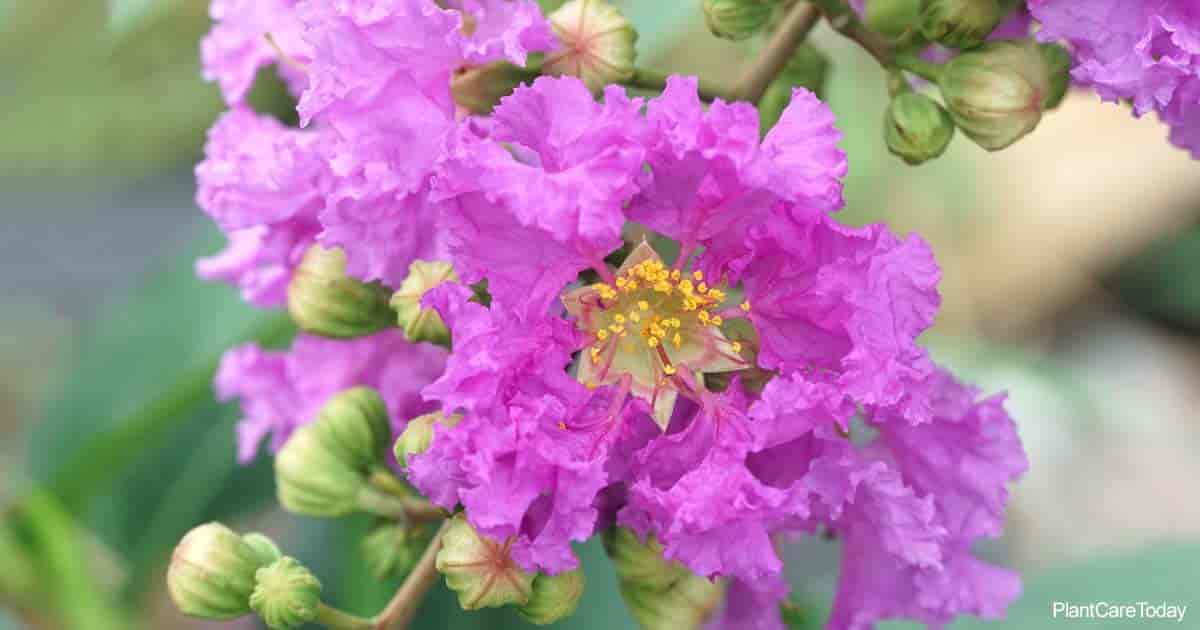Lagerstroemia speciosa [a-ger-STREEM-ee-a, spee-see-OH-suh] is a perennial or deciduous tree (crepe myrtle) from the family Lythraceae.
While this is the common scientific name, the plant is synonymously known as Adambea glabra Lam., Munchausia speciosa L, Lagerstroemia flos-reginae Retz, and Lagerstroemia reginae Roxb.

The plant is native to tropical regions in Southeast Asia.
Hence, most of their common names come from countries in southern Asia.
These include:
- Giant crepe-myrtle
- Queen’s crape-myrtle
- Pride of India Tree
- Banaba plant (Philippines)
- Jarul
- Motha Bondara
- Kakuda
- Tamhan
It is known for its crepe-like flowers and also holds value in the Theravada Buddhist religion.
The plant is believed to have been used to achieve enlightenment by the eleventh Lord Buddha.
In Sinhala and Mahaasona, it is known as Murutha.
Lagerstroemia Speciosa Care
Size & Growth
These hardy and beautiful trees look majestic when in full bloom.
Under proper growing conditions, it can grow up to 20’ – 60’ feet tall.
The bark is smooth yet flaky with branches growing deciduous leaves.
The leaves are oval or elliptic, about 3”-5” inches long and 1” – 2” inches wide.
Even though the flowers bloom just once a year and the tree takes its time to grow, it is a great addition to backyards and even along roadsides.
Flowering and Fragrance
The inflorescences of the crepe-myrtle are its glory. The crinkled, crepe-paper-like flowers are favored among gardening enthusiasts and cultivators alike.
The plants start producing flowers after 2-6 years of growth. The bloom time is during early summer/late spring or in mid-summer.
The flowers grow on erect panicles, each measuring at about 8” – 15.5” inches long. Each flower has six petals in white, purple or pink colors.
Light & Temperature
It is hardy to USDA Hardiness Zones 9 to 10. Pride of India flower loves full sun exposure when planted in moist, rich soil.
The annual daytime temperatures between 64° – 93° degrees Fahrenheit (18° – 34° C) are suitable for the plant.
In some locations, it can tolerate temperatures down to 28° degrees Fahrenheit (-2° C) but it may have a negative impact on the plant’s growth.
Watering and Feeding
It has regular water needs – 1″ per week. It tolerates a normal amount of water during the growing season.
Avoid overwatering as it may harm the roots and may even cause root rot.
Crepe myrtle trees appreciate regular fertilizing as the leaves become anemic or chlorotic.
Soil & Transplanting
These crepe myrtles thrive in fairly fertile and well-drained soils.
Rich, deep, and alluvial loam-like soils with good drainage and moisture retention are the optimal choice.
They are tolerant of alkaline soils but prefer a 5.5 to 7.5 pH.
As for transplanting, new shoots are moved easily when they are still establishing roots.
However, it’s not recommended to move the plant around.
Grooming and Maintenance
Pruning is not necessary but is done to help shape the foliage and help its growth.
Deadhead spent flowers but it’s not necessary to do so.
It is otherwise a very easy to grow and low maintenance tree.
You may also be interested in Bark Lice that attack Lagerstroemia.
How To Propagate Pride Of India
If you want to propagate with seeds, sow them in shade. Germination takes around 15 to 56 days.
When the seedlings are big enough, prick them out and transfer them to containers.
They take a while to grow in the first year and speed up.
Also propagate the plant by dividing the root suckers or with semi-hardwood, hardwood, and hardwood heel cuttings.
Pride Of India Pest or Diseases
While the plants are usually not susceptible to major pest and disease problems, it is impacted by the Rhizoctonia solani fungus.
This causes leaf blight.
If your queen’s crepe is showing signs of blight or other common problems, visit your local nursery for advice.
Known Hazard
Different parts of the plant, including the roots, stems, and leaves contain hydrocyanic acid.
A highly poisonous chemical compound also known as prussic acid.
Lagerstroemia Speciosa Uses
The Queen crape myrtle is an incredible shade tree.
Other than this, the plant has been used in agroforestry for erosion control and reforestation on the degraded hills in Java.
It is also planted in large gardens as a shade tree or centerpiece with other partial shade loving plants underneath.
Uses of the Lagerstroemia speciosa plants go beyond the garden.
It is used for extracting and isolating chemicals such as corosolic acid, lagerstroemin, flosin B, and reginin A.
It is also grown in Southeast Asia, specifically India and the Philippines, to make a special kind of tea.
In Vietnam, young leaves of Lagerstroemia speciosa are eaten as vegetables.
Scientists like Unno and more have also found the leaves to have various effects.
These include the capability of decreasing blood sugar or blood glucose levels, antidiabetic activity, and more.
In the Philippines, the plant is used for its antidiabetes property to treat diabetes mellitus or type II.
A decoction of the bark, which contains tannins, is used to treat abdominal pains.
Research on the anti-obesity activity of Lagerdtroemia speciosa and the hypoglycemic effects of extracts from these medicinal plants has also been conducted.